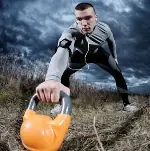
As fall begins its vast displays of beautiful colors and oppressing summer heat turns to crisp autumn air, it's hard to transition to offseason. If you keep racing into the colder months, however, you'll have to make some changes to your race routine.
Participating in cold-weather triathlons presents unique challenges compared to those of summer events. In this article, we discuss these challenges and give you the tricks triathletes use to tackle the cold so you can enjoy your fall races.
Each leg, including the transitions, in a triathlon becomes very different when it is cold outside. Water is one of the greatest conductors of heat. Losing a lot of core body temperature in the water can lead to cramping and breathing difficulties. In addition, transitioning from cold water to cycling can also results in large heat losses that may impact your performance.
A drop in body temperature also stimulates your appetite and eating not only provides fuel but generates heat to help warm your body, so remember to eat well pre-race, during the event and post race to keep warm.
Here are some tips for each leg of your cold-weather triathlon.
The Swim
- Practice swimming in cold water. This will help you become familiar with how your body reacts to colder swim environments.
- Help raise your core temperature before the race by drinking a hot beverage.
- Double cap your noggin. An extra swim cap (worn under your race cap) can do wonders.
- Get balmy. Lip balm is not just for the girls. It will not only protect uncomfortable cracked and dry lips, it will help discourage potential cold-sores and help ward off frostiness.
- Don't under-estimate the earplugs. They don't just keep out the water; they can actually help keep your core temperature up.
- Suit up. USAT rules state that competitors may wear wetsuits if the water temperature is 78 degrees or lower. If you don't own a wetsuit, it's not too late to rent. Check with your local triathlon shop or club for wetsuit rentals. Popular triathlon wetsuit brands (not the same as scuba suits) are Xterra and blueseventy.
- Acclimate to the cold water. Cold water on your face triggers your lungs to gasp for air, which causes a lot of discomfort at the beginning of a swim. Before you start your swim, dunk your face in the water.
T1 and the Bike
- Chilly extremities? Try on a pair of arm warmers, leg warmers, or gloves to keep you toasty and save time.
- Chilly arms and body? Cycling jackets, wind-breakers and vests offer quick and easy upper-body protection from the elements.
- Keep dry. If you're not racing for time, consider changing from into dry tri gear.
- Base layers are great. If you warm up quickly, try a dry-fit, wicking, long-sleeved cycling jersey over your tri suit.
- Cover your head. The wind in your hair is not great when your hair is wet and it's cold outside. Air flowing through your cycling helmet will quickly drop your core temperature. Use a wicking helmet liner or a cap that fits under or inside your helmet.
- Happy feet. Use toe covers and slip hand or foot warmer packets into your shoes. Your feet will thank you during the miles ahead.
After your cold-weather triathlon, you will cool down quickly. Make sure to dry off and cover up with a change of clothing. Put on some warm and comfy sweat pants and a hoodie to keep your head warm. Finally, refuel with a hot beverage. Anyone fancy a cup of hot cocoa?
 Extend your season: Sign up for an offseason race.
Extend your season: Sign up for an offseason race.
Indianapolis Running Examiner Davina Lewis is a scientist and personal trainer with a long history of running.
Examiner.com is the inside source for everything local. Powered by Examiners, the largest pool of knowledgeable and passionate contributors in the world, we provide unique and original content to enhance life in your local city wherever that may be.
Get ACTIVE on the Go


Couch to 5K®
The best way to get new runners off the couch and across the finish line of their first 5K.
Available for iOS | Android








Discuss This Article